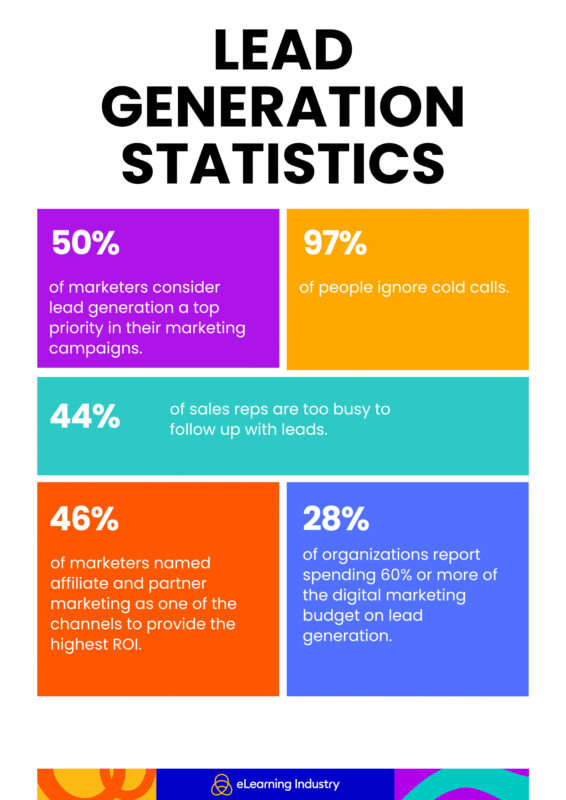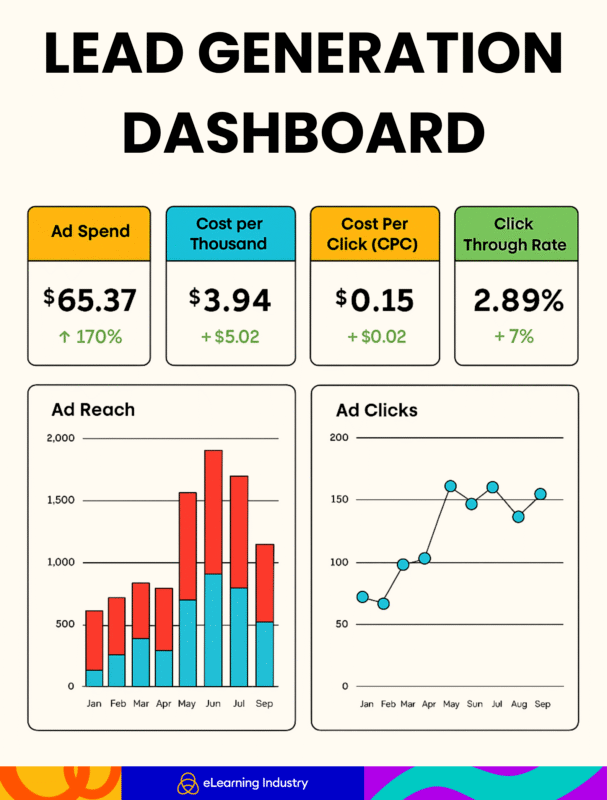The New Reality Of Lead Generation In eLearning And HR Tech
The biggest challenge in the ultra-competitive eLearning and HR tech environment is acquiring high-quality business leads consistently. In fact, 68% of B2B marketers say that consistent lead generation is tough. That's why you need to enforce the best business lead generation ideas and abandon old, outdated methods that are no longer providing you with decent results. For instance, cold outreach used to be the norm a few years ago. However, we are seeing a massive shift where marketers follow a more strategic approach instead of the usual spammy calls and emails.
Additionally, even online ads don't have the same effect they used to in demand generation for SaaS. We're all consuming so many ads that we've been pushed to use ad blockers. Therefore, potential buyers may not even view your ad, resulting in ad underperformance. That's why you must find new content strategies to generate new leads on a consistent basis and win over your audience's trust and loyalty.
Let's dive into the article and see which SaaS lead generation tactics are effective today.
In This Guide, You Will Find...
- Best Content-Led Business Lead Generation Ideas
- Paid And Sponsored Lead Generation Ideas
- Interactive And AI-Powered Business Lead Generation Ideas
- How Can You Automate Your Strategies?
- Leverage eLearning Industry For Scalable Lead Generation
- Metrics To Measure Lead Generation Success
- Common Mistakes Vendors Make (And How To Avoid Them)
Best Content-Led Business Lead Generation Ideas
1. Thought Leadership Content
Establishing thought leadership is a key priority for many eLearning and HR tech brands, as it helps them build trust among their audience. Since SaaS lead generation is hard in this highly congested field, your content should be carefully thought out and for every stage of the sales funnel. Starting with in-depth articles and eBooks, your goal is to educate and inform your prospects regarding matters that trouble them daily. Identify industry challenges, pain points, and goals, and create insightful content with unique analyses and smart tips.
Additionally, you can create whitepapers, research reports, and surveys to attract attention to your website and generate qualified leads. Through them, you showcase your unique industry knowledge and your ability to forecast future trends. These documents are typically used as gated content in order to help you gather more contact information and add more users to your email list.
You may use snippets from these documents to create social media posts and infographics to keep your following updated.
2. Case Studies And Testimonials
Among the best business lead generation ideas are case studies and testimonials. Why? Because they both serve the same goal: creating an impeccable brand reputation. For starters, most eLearning and HR tech businesses ask their buyers to rate them and write a review on various sites, including Google, PPC directories, and their website. Customer testimonials are the best kind of shout-outs you need to get, simply because they are genuine and focus on your company's value. You may then add them to product pages or your main page to drive trust.
Case studies, on the other hand, are documents you create based on specific customer cases. You detail the problem a client faced before, what methods you used, and which challenges you faced to help them improve. You must also provide actionable insights and data backing your claims. It's best to get a lengthy quote from your customers to make your case study even more sturdy.
3. eBooks, Templates, And Checklists
These downloadable gated assets are often used to lure in potential buyers, make them hand out their contact information, and add them to your email list so you can nurture them. This gated content strategy is very effective in gathering attention to your website and services. The more resources people download, the higher opinion they have regarding your expertise. Therefore, you increase your chances of converting them into buyers. For example, when you are a marketer offering users a customer review template, you show them that you have deep knowledge of client psychology and email copy. So, they will trust you more easily to handle their company's marketing initiatives.
Checklists are also quite easy to create and come in handy for any brand looking for quick tips. But how do you even generate buzz regarding your assets? To promote templates and checklists and eBooks, you can choose industry-specific companies like eLearning Industry. Their audience is filled with eLearning and HR tech pros actively looking to buy or download solutions.

Paid And Sponsored Lead Generation Ideas
1. Social Media Ad Campaigns
Publishing lead magnets organically is the most viable scenario for all businesses. However, relying solely on organic traffic isn't enough. Among the best paid business lead generation ideas is to invest in social media advertising. B2B brands usually leverage lead generation ads on Facebook, Twitter, and LinkedIn. You can try out Instagram, too, but it's not really where B2B buyers go to find solutions.
These platforms offer great targeting, allowing you to set demographic and psychographic information. This way, you can reach high-intent leads and segments that align with your buyer personas. Not only that, but you can run retargeting ads too, making it easier to grab people's attention again and again if they initially engaged with your ad but didn't give you their click.
Talking about ads, you can even invest in banner ads on trustworthy and niche-specific websites whose audience aligns heavily with yours.
2. Pay-Per-Click (PPC) Campaigns
9 in 10 users say that they have encountered an online ad while browsing. So, ads are everywhere. With the average PPC cost being $0.11-$0.50 per click, it's understandable why this model is so popular among CEOs and growth marketers. But it's not only the low cost that makes PPC lead generation so alluring. You can also test messages, measure results, and optimize your campaigns quickly and efficiently. Where should you create PPC ads, though? Are Google and social media enough? Not for niche B2B brands.
HR software lead generation and LMS vendor marketing require more niche directories that generate the right leads. Yes, Google may get tremendously higher traffic, but it's not niche. G2 and Capterra are two of the most popular directories, but they are also not specific to an industry. eLearning Industry, on the contrary, generates interest from corporate buyers who are actively looking to buy eLearning and HR software to cover their companies' needs.
So, start by creating your free listing and upgrade it later if you want to appear at the top of the list and surpass your competition.
Interactive And AI-Powered Business Lead Generation Ideas
1. Quizzes And Polls
People love taking quizzes, voting in polls, and basically, interacting with online content. That's why this is one of the best business lead generation ideas you should incorporate into your digital marketing strategy. Think of yourself as being a detective and quizzes as bait. You ask your audience to answer simple questions and find something out about themselves while you also learn more about them, their preferences, and their challenges. Therefore, you nurture leads effectively, and you can promote products and services that appeal to their needs.
Polls are simpler than quizzes, as you ask people to pick one answer to your question. They are equally valuable, though, on many occasions. For example, you may need to decide what your next product feature will be and have a list of four potential ones. Asking your audience which one is more valuable to them helps you decide faster.
2. Calculators
Let's say you've created payroll software and want to attract more buyers. Apart from creating social media posts, articles, and videos, you can offer visitors a free calculator so they can estimate yearly expenses for staff. Over time, these free visitors may consider trying out your software, as they can see how their life is from just using your calculator. Basically, your goal with enforcing interactive content is to increase user engagement. This is the hardest to achieve in this new B2B landscape, where everyone is online.
Once you get people's attention, it's easier to promote your products and use account-based marketing to personalize your approach. When you offer initial value to people's lives, it shows them that you don't want to trick them but actually help them.
3. Podcasts And Webinars
We couldn't be talking about the best business lead generation ideas and not mention podcasts and webinars. Event marketing used to be more about in-person conferences and seminars. Now, the business world is embracing the remote side of meeting and engaging with people from all around the globe. Webinars are excellent for showcasing your expertise without necessarily promoting your product. You have the opportunity to interact with potential buyers, offer solutions to their challenges, and follow up with them after the webinar ends.
Podcasts are a bit different. You can publish episodes weekly and invite influential figures to discuss certain subjects. The goal here is to build trust with your listeners and a deeper human connection. In fact, 80% of buyers say a company's experience is more important than its products. Hearing you speak makes people connect to you and admire your persona.
How Can You Automate Your Strategies?
Among the best business lead generation ideas, automation stands out as a powerful way to save time and boost results. B2B growth marketers and CEOs can use B2B marketing automation tools to capture and nurture leads with minimal manual effort. For instance, chatbots can qualify visitors, while CRM systems track interactions and trigger personalized email sequences. These B2B lead generation strategies work around the clock, analyzing behavior and delivering tailored content to each prospect.
You can also connect your website forms, social media ads, and analytics platforms to create a complete ecosystem that gathers and filters leads automatically. Over time, this approach helps you identify which campaigns bring the highest ROI and which messages resonate most with your audience. When automation runs smoothly, it strengthens your entire sales funnel, helping you convert interest into long-term, loyal business relationships.
Leverage eLearning Industry For Scalable Lead Generation
If you're a B2B brand in the eLearning or HR tech field, the eLearning Industry platform is one of the best business lead generation ideas to scale your visibility and attract qualified buyers. With thousands of professionals searching for learning and talent solutions daily, it's a powerful space to showcase your expertise. You can use our PPC directories to appear at the top of category listings, sponsor banner ads to boost brand awareness, or publish press releases announcing product updates and achievements.
Combining these tactics with targeted email marketing helps you reach decision-makers directly and nurture leads over time. Additionally, publishing insightful guest articles or case studies on eLearning Industry builds credibility and positions your brand as a trusted authority. You can submit your free post or choose to publish an original or republished piece of content, as we are an established content syndication platform.
Additionally, you can leverage our Top Lists and eLI Top List Awards to stand out from the crowd and appear at the top.

Metrics To Measure Lead Generation Success
-
Conversion Rate Per Channel
Tracking your conversion rate per channel helps you identify which of the best business lead generation ideas drive the most engagement. By comparing performance across email, social, and paid media, you can refine your lead gen campaigns for higher efficiency. This metric reveals how effectively each channel attracts visitors who take meaningful action, guiding you to focus resources where they truly generate qualified leads.
-
Cost Per Qualified Lead
Measuring cost per qualified lead shows how efficiently your marketing budget turns interest into opportunities. By analyzing expenses across campaigns, you can determine which platforms deliver the most value. This metric also helps balance spending between quick wins and long-term growth. Keeping costs low while maintaining quality ensures your demand generation campaigns stay profitable and scalable, optimizing every dollar spent to nurture genuine business prospects.
-
Lead Quality Scoring
Lead quality scoring helps you evaluate how closely new prospects align with your target buyer profile. By assigning points based on engagement, behavior, and company fit, you can prioritize which leads deserve immediate attention. This approach sharpens your campaigns by helping sales teams focus on those most likely to convert, improving collaboration between marketing and sales while shortening the overall sales cycle.
-
Sales Pipeline Contribution
Understanding your sales pipeline contribution highlights how the best business lead generation ideas influence real revenue. It connects marketing performance directly to closed deals, showing which sources and tactics generate qualified leads that move forward. This metric also supports effective sales pipeline management, helping teams track progress and identify bottlenecks. It bridges the gap between awareness and action, revealing the true impact of demand generation campaigns and ensuring every marketing effort drives measurable business growth and long-term profitability.
-
ROI Per Campaign/Asset
ROI per campaign or asset measures the tangible return on your marketing investments. It tracks how much revenue each content piece, ad, or strategy generates compared to its cost. This insight helps you refine your lead gen campaigns by identifying what's delivering the strongest outcomes. Over time, monitoring ROI ensures your marketing team continues building smarter, data-driven systems for sustainable growth and higher conversion potential.
Common Mistakes Vendors Make (And How To Avoid Them)
-
Overemphasizing Volume Over Quality
Focusing too much on sheer numbers can hurt results. The best business lead generation ideas prioritize lead quality vs lead quantity, ensuring your team spends time on prospects most likely to convert. Generating thousands of uninterested contacts may inflate metrics but won't grow revenue. Instead, focus on targeted leads and strategies that encourage meaningful engagement.
-
Not Using Segmentation
Just because you don't have as many prospects as B2C companies, it doesn't mean that you should put all of them in the same basket. Use firmographics, unique needs, and behavioral patterns to segment your audience. Then, create different value propositions and email copy to appeal to their preferences and challenges. You don't need to create a million segments, just enough to understand the common ground of each segment.
-
Relying Only On Internal Traffic Sources
Limiting lead generation to your website or email list reduces reach. Incorporate diverse lead generation techniques like social ads, webinars, and partnerships to attract new audiences. Expanding beyond internal channels ensures your pipeline remains healthy and full of qualified prospects.
-
Neglecting Follow-Up Automation
Many vendors fail to automate follow-ups, which can let opportunities slip away. Implement email marketing funnels to nurture leads consistently, keeping your brand top of mind and moving prospects closer to conversion.
-
Letting Hot Leads Go Cold
Even strong leads can disappear if ignored. The best business lead generation ideas include timely follow-ups and structured outreach to keep targeted leads engaged and ready to buy, maximizing your ROI.
Key Takeaway
Successful lead generation for eLearning and HR tech vendors requires more than just traditional outreach today. Brands that embrace inbound lead generation strategies, create valuable gated assets like eBooks and lead generation templates, and focus on delivering meaningful content see higher engagement and stronger trust from potential buyers. By combining content-led strategies with targeted campaigns, companies can attract qualified prospects consistently while positioning themselves as industry thought leaders.
Equally important is implementing lead scoring and nurturing systems to prioritize and engage prospects effectively. Automation, follow-up AI workflows, and timely outreach ensure that high-intent leads move through the funnel efficiently, reducing the risk of letting opportunities go cold. By tracking performance across channels and optimizing campaigns based on results, brands can build a repeatable, scalable lead generation engine. Focusing on quality, relevance, and structured nurturing ensures consistent growth and measurable success in today's crowded B2B environment.
Thought leadership articles, case studies, and downloadable resources like eBooks and checklists are highly effective in attracting and nurturing leads.
LinkedIn campaigns and pay-per-click (PPC) ads are powerful tools for targeting professionals in the eLearning and HR tech sectors.
Quizzes, calculators, webinars, and AI chatbots can engage visitors and qualify leads effectively.
Utilize CRM systems and marketing automation tools to streamline lead capture, nurturing, and follow-up processes.
Key metrics include conversion rates, cost per qualified lead, lead quality scoring, sales pipeline contribution, and ROI per campaign.
Avoid overemphasizing volume over quality, neglecting segmentation, relying solely on internal traffic, and failing to automate follow-ups.

